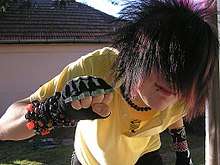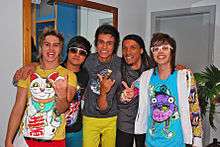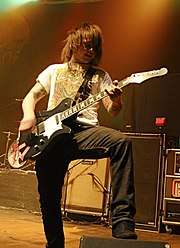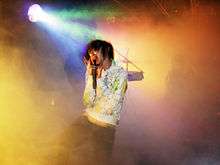Scene (subculture)
The scene subculture is a youth subculture that emerged in the United States and the United Kingdom during the early 2000s. The subculture became popular with adolescents from the mid-late 2000s to the early 2010s. Members of the scene subculture are referred to as scene kids, trendies, or scenesters.[1] Scene fashion consists of skinny jeans, bright colored clothing, a signature hairstyle consisting of straight, flat hair with long fringes covering their forehead, and bright colored hair dye.[2] Music genres associated with the scene subculture include post-hardcore, metalcore, crunkcore, deathcore, electronic music, and pop punk.[3][4]

From the late 2000s to mid 2010s, scene fashion gained popularity among teens and the music associated with the subculture achieved commercial success in both the underground and the mainstream. Groups like Bring Me the Horizon, Asking Alexandria, Pierce the Veil, Metro Station, Twenty One Pilots, and Owl City garnered mainstream attention and large audiences while still largely being tied to the scene subculture. In the late 2010s, the scene subculture lost popularity. The scene subculture has been confused with the emo subculture.[5]
Subculture
Fashion

Scene fashion is known for its bright colored clothing, skinny jeans, stretched earlobes, sunglasses, piercings, large belt buckles, wristbands, fingerless gloves, eyeliner, hair extensions, and straight, androgynous flat hair with long bangs covering the forehead and sometimes one or both eyes. Scene people often dye their hair colors like blond, pink, red, green, or bright blue.[2][6][5][7] Members of the scene subculture often shop at Hot Topic.[8] According to The Guardian, a scene girl named Eve O'Brien described scene people as "happy emos".[7] Scene kids' hairstyles have caused scene fashion to be confused with emo fashion.[5]
Music

Scene people are associated with multiple styles of music including metalcore, deathcore, post-hardcore, crunkcore, electronic music and pop punk. Artists commonly associated with the scene subculture include 3OH!3, Metro Station, Cute Is What We Aim For, Brokencyde, Asking Alexandria, Black Veil Brides, Attack Attack!, We Came As Romans, Bring Me the Horizon, Blood on the Dance Floor, Jeffree Star, Cobra Starship, Paramore, Millionaires, Boys Like Girls, Mayday Parade, Suicide Silence, Hollywood Undead, the Medic Droid, Breathe Carolina, Escape the Fate, Falling in Reverse, Hawthorne Heights, All Time Low, Lights, Taking Back Sunday and Design the Skyline.[6][9][10][11][12][13][7][14][15] Many bands associated with the scene subculture gained popularity through the social media website Myspace.[16]
History

The scene subculture emerged in the UK during the early-mid 2000s following the mainstream exposure of the emo subculture. The scene subculture is considered by some to have developed directly from the emo subculture and thus the two are often compared.[17] During the mid-2000s, members of the British and American scene subculture were a part of the deathcore music scene. In a 2005 article by Phoenix New Times, writer Chelsea Mueller described the appearance of the band Job for a Cowboy (a band that was deathcore at the time) by writing that the band "may look like scenesters with shaggy emo haircuts and tight pants, and may mock metal greats, but this death-metal band is for real."[18] Mueller described Job for a Cowboy as "five guys in girls' jeans and tight band tee shirts".[18] Another early deathcore group popular among members of the scene subculture is Bring Me the Horizon.[10]
The music festival Warped Tour became popular with members of the scene subculture during the 2000s. Artists associated with the subculture would often play at the festival.[3]
Blood on the Dance Floor became popular with scene kids as well, especially after Jayy Von Monroe joined as lead singer in 2009.[19]
By the mid 2010s the subculture had seen a decline in popularity.[20] Warped Tour had its last show in 2019 after running annually since 1995.
Criticism

According to an article by The Sydney Morning Herald from March 30, 2008, emo people have criticized the scene subculture, accusing scene people of "ripping off their style."[5] The scene subculture has also been the subject of criticism from members of the heavy metal subculture. Pejorative terms such as "myspace-core", "scenecore", “mallcore” and "emocore" have been used to describe scene music and artists.[16] These terms mock the use of the suffix “-core” which has been used to describe genres related to the scene subculture such as metalcore, crunkcore, and deathcore.[21] Crunkcore has received criticism and the genre has been poorly received by music reviewers. The Boston Phoenix has mentioned criticism of the style, saying that "the idea that a handful of kids would remix lowest-common-denominator screamo with crunk beats, misappropriated gangsterisms, and the extreme garishness of emo fashion was sure to incite hate-filled diatribes".[22] Deathcore has been criticized by members of the heavy metal community for its use of breakdowns.[23][24][25][26][27]
References
- http://www.thekindland.com/culture/voices-on-being-scene-even-when-youre-not-a-kid-1576
- "12 things all former scene kids know to be true". April 3, 2018.
- "A Final Pilgrimage To Warped Tour, As Told By A Former Scene Kid". August 2, 2018.
- "A History of Counterculture: Emo and Scene". College Fashion. November 14, 2018.
- Marcus, Caroline (March 30, 2008). "Inside the clash of the teen subcultures". The Sydney Morning Herald. Retrieved July 29, 2018.
- Palmer, Bobby (July 5, 2017). "The cringe things you'll remember if you were a scene kid in the mid-2000s". The Tab. Retrieved July 29, 2018.
- Rogers, Jude (February 25, 2010). "From mod to emo: why pop tribes are still making a scene". The Guardian. Retrieved July 29, 2018.
- "2009: The Year That Broke The Scene". Vinyl Me Please. March 6, 2019.
- D, Sergeant (January 4, 2012). "2012 State of the Scene Address: It's Cool to Be Tr00". MetalSucks. Retrieved July 29, 2018.
- Rauf, Raziq (November 6, 2006). "Bring Me The Horizon: "It's just party music"". Drowned in Sound. Retrieved July 29, 2018.
- Jeffries, David. "Evolution – Blood on the Dance Floor". AllMusic. Retrieved July 29, 2018.
- Penn, Farrah (June 18, 2016). "34 Songs All Scene Kids Definitely Had On Their Myspace". BuzzFeed. Retrieved July 29, 2018.
- Shotwell, James (August 17, 2011). "Review: Design The Skyline – Nevaeh". Under the Gun Review. Retrieved July 29, 2018.
- Castillo, Arielle (February 29, 2012). "Download: Lights – "Toes (Woodhands Remix)"; Culture Room Show March 11". New Times Broward-Palm Beach. Retrieved July 29, 2018.
- Shotwell, James (July 15, 2011). "Review: Falling In Reverse – The Drug In Me Is You". Under the Gun Review. Retrieved July 30, 2018.
- Irizarry, Katy. "16 Bands Who Got Their Start on MySpace". Loudwire.
- "11 Ways Emo & Scene Styles Were Different". Bustle.
- Mueller, Chelsea (December 1, 2005). "Molten Rock". Phoenix New Times. Retrieved July 29, 2018.
- Staff, Inked Mag. "You Won't Believe What This Blood on the Dance Floor Singer Does Today!". Tattoo Ideas, Artists and Models.
- "The cringe things you'll remember if you were a scene kid in the mid-2000s". UK. July 5, 2017.
- Wilson, Scott A. (2015-05-26). Music at the Extremes: Essays on Sounds Outside the Mainstream. ISBN 9780786494507.
- Gail, Leor (14 July 2009). "Scrunk happen: man kids seem to like it". Boston Phoenix. Retrieved 8 October 2009.
- Wilson, Scott A. (2015). Music at the Extremes: Essays on Sounds Outside the Mainstream. McFarland. pp. 20–21. ISBN 9780786494507.
- "A Deathcore Extravaganza". Review the World. Archived from the original on 16 February 2013. Retrieved 5 January 2013.
- "Leave The Pig Squeals on The Farm". American Aftermath. September 26, 2010. Archived from the original on 2013-05-24.
- "Why Do Metal Nerds Like All These Deathcore Bands????". Sergeant D from MetalSucks. May 16, 2012.
I like this band OK, but I think it's really funny how when they first came out everybody was like "WTF this band sucks they are posers/not real death metal!!!" Then they put out their second album, which was basically generic late-90s death metal like any of the 8962323 jillion bands who ripped off Cannibal Corpse and Suffocation at the time, and then everybody was all "I guess they are OK this record is pretty sweet."
- "Deathcore... and how hard it is to find good bands???". David Dawson. October 15, 2012. Archived from the original on April 19, 2013.